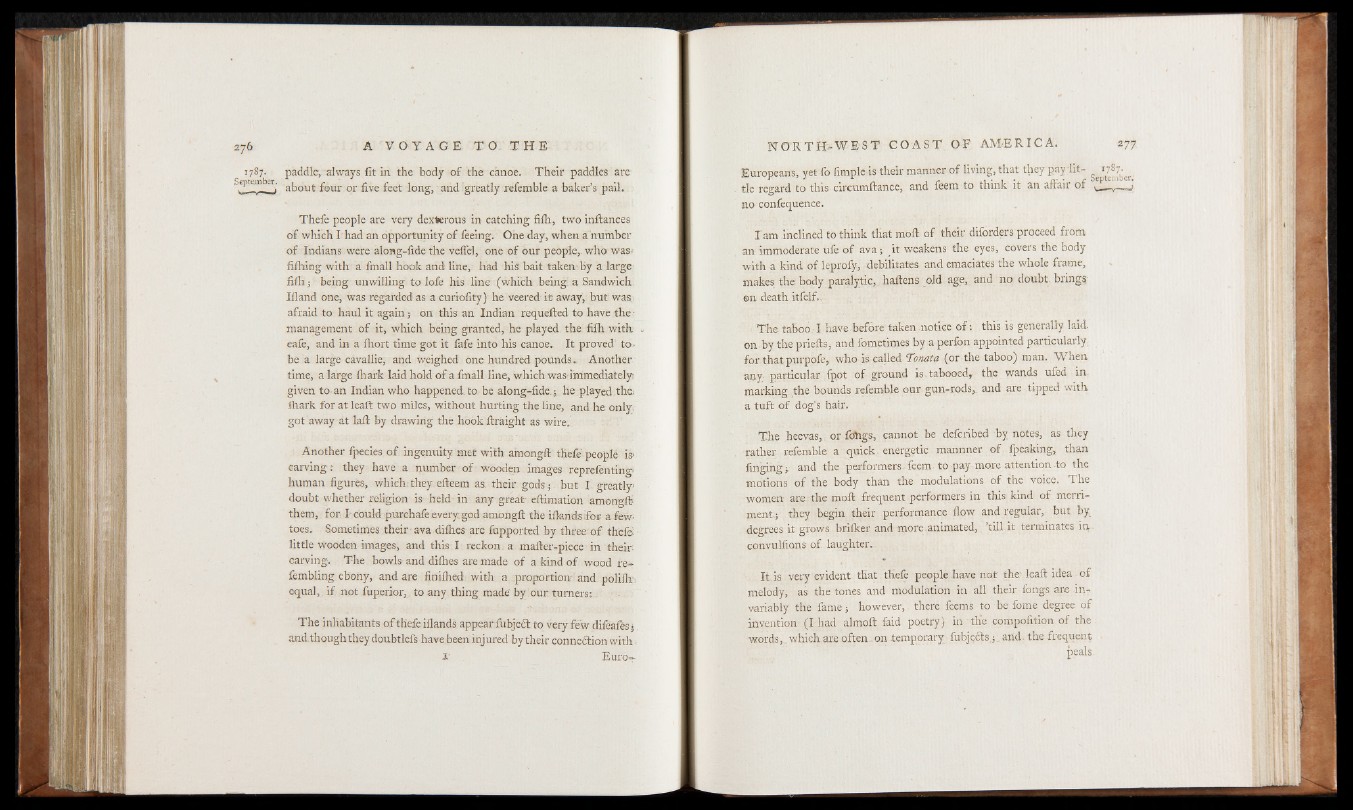
276 A V O Y A G E T O T H E
1787. paddle, always fit in the body of the canoe. Their paddles are
S e p tem b e r . apout; f o u r o r £ v e feet iong5 and greatly referable a baker’s pail.
Thefe people are very dexterous in catching filh, two inftances
of which I had an opportunity of feeing. One day, when a number
of Indians were along-fide the veffel, one of our people, who was.-
fifhing with a finall hook and line, had his: bait taken; by a large
fifh ; being unwilling to lofe his line (which being; a Sandwich.
Iiland one, was regarded as a currofity) he veered it away, but was.,
afraid to haul it again > on this an Indian requefted to have the -
management of it, which being granted, he played the filh with
eafe, and in a Ihort time got it fafe into his canoe. It proved' to-
be a large cavallie, and weighed one hundred pounds» Another
time, a large fhark laid hold of a.fmall line, which wasImmediately!
given to an Indian who happened, to be along-fide; he played the
lhark for at leaft two miles, without hurting the line, and he only,
got away at laft by drawing the hook ftraight as wire..
Another fpecies o f ingenuity met with amongft thefe people is>
carving: they have a number of wooden images reprefenting>
human figures, which ; they , efteem as their gods ; but I greatly
doubt whether religion is held- in any great eftimation amongft
them, for I could purchafe every- god amongft the ifknds for a few-
toes. Sometimes their- ava difhes are fupported by three-of thefe;
little wooden images, and this I reckon, a, mafter-piece in their
carving. The bowls- and dilhes are made of a kind of wood re*
fembling ebony, and are finilhed with a proportion and polifir
equal, if not fuperior,. to any, thing made by our turners:,
The inhabitants of thefe iflands appear fubject to very fe w difeales •
and, though they doubtlefs have been injured by their connection with
X Euro-
NO’E T H -W E S T C O A S T OF AM F R I C A .
Europeans, yet fo fimple is their manner of living, that they pay-lit- gj^ -
tie regard to this circumftance, and feem to think it an affair of
no confequence.
I am inclined to think that moll of their diforders proceed from
an immoderate ufe of ava; it weakens the eyes, covers the body
with a kind of leprofy, debilitates and emaciates the whole frame,
makes the body paralytic,, haftens old age, and no doubt brings
en death itfelf..
The taboo I have before taken notice of: this is generally laid
on by the priefts, and fometimes by a perfon appointed particularly;
for that purpofe, who is called T 'mata (or the taboo) man. When
any particular fppt of ground is.tabooed, the wands uled in.
marking the bounds referable our gun-rods,, and are tipped with
a tuft of dog’s hair.
The heevas, or fdhgs, cannot be defcribed by notes, as they
rather referable a quick, energetic mannner of fpeaking, than
finging; and the p e r fo rm e rs - feem to pay more attention-to the
motions of the body than the modulations of the voice. The
women are.the moll frequent performers in this kind of merriment.;
they begin their performance flow and regular, but by
degrees it grows brilker and more.animated, ’till.it terminates in
convulfions of. laughter..
It.is very evident, that.thefe people have not the- leaft idea.of
melody, as the tones and modulation in all their fongs are invariably
the fame; however, there feems to be fome degree of
invention- (I had almoft faid poetry) in the compofition of the
words, .which, are often.on .temporary fubj eels,; „and. the Frequent
peals